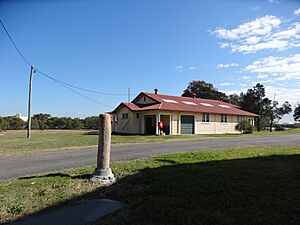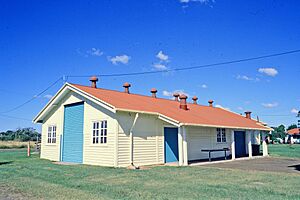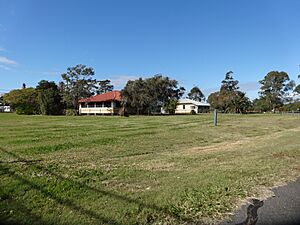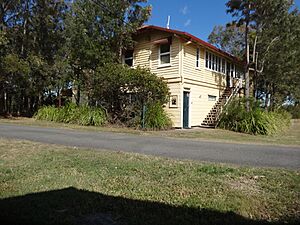Lytton Quarantine Station facts for kids
Quick facts for kids Lytton Quarantine Station |
|
|---|---|
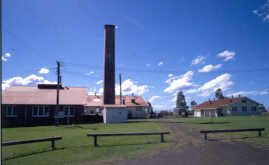
Lytton Quarantine Station
|
|
| Location | 160 South Street, Lytton, City of Brisbane, Queensland, Australia |
| Design period | 1900 - 1914 (early 20th century) |
| Built | 1913 - c. 1914 |
| Official name: Lytton Quarantine Station (former), Customs Reserve, Fort Lytton National Park, Lytton Quarantine Complex and Animal Detention Centre | |
| Type | state heritage (built, archaeological) |
| Designated | 22 September 2000 |
| Reference no. | 601347 |
| Significant period | 1913-1914 (fabric) 1859, 1889, 1914-1982, 1919 (historical) |
| Significant components | shed/s, sewage farm/treatment site, machinery/plant/equipment - health/care services, jetty/pier, residential accommodation - staff housing, bathroom/bathhouse, objects (movable) - law/order, immigration, customs, quarantine, tramway, workshop, trees/plantings, yard, drainage, reception area/house, residential accommodation - doctor's house/quarters, chimney/chimney stack, disinfecting room, laundry / wash house, boiler room/boiler house, slab/s - concrete |
| Lua error in Module:Location_map at line 420: attempt to index field 'wikibase' (a nil value). | |
The Lytton Quarantine Station is a historic site in Lytton, a suburb of Brisbane, Australia. It was built between 1913 and 1914. For many years, it was the first stop for new immigrants arriving by ship. People who might have been sick were kept here to make sure they didn't spread diseases to others.
Today, the station is part of the Fort Lytton National Park and is listed on the Queensland Heritage Register. This means it is protected because of its importance to Australia's history.
Contents
History of the Station
The Lytton Quarantine Station opened in 1913. Its main job was to house new arrivals and anyone who might be carrying an infectious disease. The station was built in an isolated spot at the mouth of the Brisbane River. This location was chosen to keep any potential sickness away from the general public.
Before Lytton, other places around Moreton Bay were used for quarantine. A station at Dunwich on Stradbroke Island was used from 1844. For a short time, St Helena Island was used, and later, Peel Island became Brisbane's quarantine station from 1874 to 1915.
From Customs to Quarantine
The land at Lytton had many uses before it became a quarantine station. In the 1850s, it was a customs area. A customs station's job was to check ships and goods coming into the port to collect taxes. A village was planned, and a Tide Surveyor was stationed there to board all incoming ships.
After Queensland became its own colony in 1859, Lytton remained an important customs entry point. Over the years, buildings like a telegraph station, pilots' houses, and a wharf were built. In 1877, the government decided to build a fort nearby to protect the river entrance. This became Fort Lytton, which was built between 1880 and 1882.
In the 1880s, a small area was set aside for animal quarantine. This was to check imported animals for diseases. By 1900, more land was added for this purpose.
A New Federal Responsibility
When the Commonwealth of Australia was formed in 1901, quarantine became a job for the federal government. Dr. John Simeon Colebrook Elkington, a health expert, was put in charge of setting up Queensland's quarantine system. He oversaw the creation of the Lytton facility.
Construction began in 1913. The station included an administration building, a small hospital, and living quarters for staff and people in quarantine. The buildings were made of wood with corrugated iron roofs and were raised on low concrete stumps.
A very important moment for the station came in 1919. After World War I, a deadly flu pandemic spread across the world. Thanks to the strict quarantine at Lytton for returning soldiers, the flu's arrival in Brisbane was delayed by about three months. This saved many lives.
Life at the Station
By the 1920s, the station was a busy place. Health officers would meet ships at the river mouth and inspect everyone on board. Anyone suspected of being sick was brought to Lytton.
The station had a jetty where passengers could walk ashore. A small tram line carried luggage and sick people from the jetty to a reception house. There was a large bathing block where people could wash. There was also a steam disinfector to clean luggage and other items. Special separate areas were set up for passengers from Asia.
The station continued to be used for human quarantine until the early 1980s. After that, it was used only for animal quarantine for a few more years before closing down completely.
The Site Today
In 1988, the Queensland Parks and Wildlife Service took over management of the site. It is now part of the Fort Lytton National Park. Many of the original buildings are still standing and give us a glimpse into the past.
The building that is now the park's administration centre was once the doctor's house. It was moved from another part of the quarantine station to its current spot.
What Remains of the Station
The former Lytton Quarantine Station has many interesting structures that you can still see today. These buildings help tell the story of what life was like for people in quarantine.
Key Buildings and Structures
- Jetty: A wooden jetty where ships would dock. Passengers and supplies came ashore here.
- Reception House: A small wooden building where new arrivals were processed. Old tram tracks run under its porch.
- Bath House: A large building where people had to shower. It had a concrete floor and vents on the roof.
- Boiler House: A brick building with a tall chimney. It created steam for the disinfecting block and laundry.
- Disinfecting Block: A large wooden building where luggage was cleaned using steam. It still has the original machinery, called an autoclave, inside.
- Laundry Block: A wooden building where clothes and linens were washed. It has a large, fenced yard with posts for clotheslines.
- Launchmen's Cottages: Two houses where the men who operated the station's boats lived with their families.
- Doctor's Quarters: This building was the home for the station's doctor. It is now used as the park's office.
- Sewerage Treatment Plant: A small concrete structure that was an early form of waste treatment for the station.
The grounds around the buildings are mostly grass, with some mature trees. The layout of the buildings still shows how the station was organized to keep people separated and prevent the spread of disease.
Why is it a Heritage Site?
The Lytton Quarantine Station was listed on the Queensland Heritage Register in 2000. This is because it is a very important place for several reasons:
- It shows Queensland's history: The site tells the story of early customs, animal quarantine, and human quarantine in the state.
- It is rare: It is one of the best surviving examples of an early 20th-century quarantine station in Australia.
- It teaches us about the past: The buildings and layout show how people dealt with infectious diseases over 100 years ago.
- It has a special connection to people: For nearly 70 years, this station was the first Australian experience for many immigrants.
- It is linked to an important person: The station is a great example of the work of Dr. J.S.C. Elkington, a key figure in Australian public health.
See also
- List of tramways in Queensland



